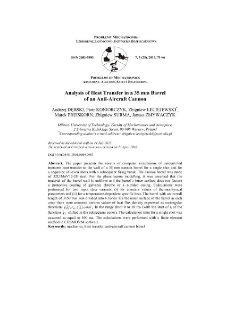Nasza Biblioteka Cyfrowa udostępnia 1 868 obiektów cyfrowych
Obiekt
Tytuł: Analysis of Heat Transfer in a 35 mm Barrel of an Anti-Aircraft Cannon ; Analysis of Heat Transfer in a 35 mm Barrel of an Anti-Aircraft Cannon
Tytuł odmienny:
Analiza wymiany ciepła w 35 mm lufie armaty przeciwlotniczej ; Analiza wymiany ciepła w 35 mm lufie armaty przeciwlotniczej
Współtwórca:
Andrzej DĘBSKI, Piotr KONIORCZYK, Marek PREISKORN, Zbigniew SURMA, Janusz ZMYWACZYK ; Andrzej DĘBSKI, Piotr KONIORCZYK, Marek PREISKORN, Zbigniew SURMA, Janusz ZMYWACZYK
Abstrakt:
The paper presents the results of computer simulations of unidentified transient heat transfer in the wall of a 35 mm cannon barrel for a single shot and for a sequence of seven shots with a subsequent firing break. The cannon barrel was made of 32CrMoV12-28 steel. For the phenomenon modelling, it was assumed that the material of the barrel wall is uniform and the barrel’s inner surface does not feature a protective coating of galvanic chrome or a nitrided casing. Calculations were performed for two input data variants: (i) for constant values of thermophysical parameters and (ii) for a temperature-dependent specific heat. The barrel with an overall length of 3150 mm was divided into 6 zones. On the inner surface of the barrel in each zone there were assumed various values of heat flux density expressed as rectangular functions in the range from 0 to 10 ms (with the start of ti of the function shifted in the subsequent zones). The calculation time for a single shot was assumed as equal to 100 ms. The calculations were performed with a finite element method in COSMOS/M software.
;
The paper presents the results of computer simulations of unidentified transient heat transfer in the wall of a 35 mm cannon barrel for a single shot and for a sequence of seven shots with a subsequent firing break. The cannon barrel was made of 32CrMoV12-28 steel. For the phenomenon modelling, it was assumed that the material of the barrel wall is uniform and the barrel’s inner surface does not feature a protective coating of galvanic chrome or a nitrided casing. Calculations were performed for two input data variants: (i) for constant values of thermophysical parameters and (ii) for a temperature-dependent specific heat. The barrel with an overall length of 3150 mm was divided into 6 zones. On the inner surface of the barrel in each zone there were assumed various values of heat flux density expressed as rectangular functions in the range from 0 to 10 ms (with the start of ti of the function shifted in the subsequent zones). The calculation time for a single shot was assumed as equal to 100 ms. The calculations were performed with a finite element method in COSMOS/M software.
Miejsce wydania:
Warszawa
;
Warszawa
Wydawca:
Wojskowa Akademia Techniczna ; Wojskowa Akademia Techniczna
Data utworzenia:
Data złożenia:
Data akceptacji:
Data wydania:
Rozmiar:
Identyfikator:
oai:ribes-88.man.poznan.pl:2289
Sygnatura:
DOI 10.5604/01.3001.0009.2983 ; DOI 10.5604/01.3001.0009.2983
ISSN elektroniczny:
ISSN drukowany:
Język:
Właściciel praw:
Wojskowa Akademia Techniczna ; Wojskowa Akademia Techniczna
Strona początkowa:
Strona końcowa:
Tom:
Słowa kluczowe:
mechanics, heat transfer, anti-aircraft cannon barrel ; mechanics, heat transfer, anti-aircraft cannon barrel
Kolekcje, do których przypisany jest obiekt:
Data ostatniej modyfikacji:
24 lip 2025
Data dodania obiektu:
24 lip 2025
Liczba wyświetleń treści obiektu:
0
Wszystkie dostępne wersje tego obiektu:
https://ribes-88.man.poznan.pl/publication/2589
Wyświetl opis w formacie RDF:
Wyświetl opis w formacie OAI-PMH:
| Nazwa wydania | Data |
|---|---|
| Analysis of Heat Transfer in a 35 mm Barrel of an Anti-Aircraft Cannon | 24 lip 2025 |

